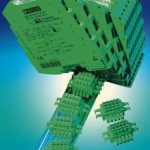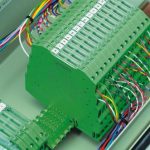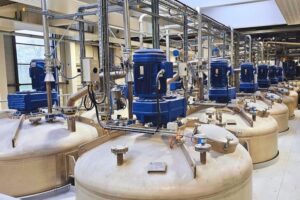The slender 6.2 mm Mini Analog signal converters can be used for all common analogue signal transmission applications. Owing to their compact design and their power bridging system, they are particularly suitable for use in decentralised systems. The consistent harmonisation of their technical features, as well as their comprehensive approvals and their usability in Ex applications, helps users plan and maintain their systems more easily.
Thomas Oesselke
Alongside factory automation, digital signal processing is also increasingly important in process engineering. Nevertheless, there are commercial and technical reasons that favour the use of analogue data transmission. Traditional analogue technology is frequently employed to provide long-term availability, particularly in process engineering where systems can sometimes operate for several decades. This aspect is often compounded by explosion protection requirements, which can only be met at a considerable cost using fieldbus technology. The increased expenditure for Ex-compatible fieldbus systems is disproportionate, especially when the number of signals to be captured in the hazardous area only accounts for a fraction of the total. In this case, it is much more cost-effective to use analogue signal transmission technology in Ex Zone 2. Mini Analog signal converters from Phoenix Contact offer solutions for all common analogue signal transmission applications, including process engineering.
The challenge of analogue technology
Even when EMC effects and potential differences are present, useful signals between sensors and actuators in the field must still be reliably transmitted to the control technology on the control level. When sensor signals are transmitted over long distances, they have to be amplified. Voltage signals often also need to be converted to current signals, which are less prone to interference. The trend towards decentralisation in automation technology likewise places further demands on the signal processing components. Space requirements, power consumption and operating conditions are particularly affected. Mini Analog signal converters meet these requirements impressively.
Electrical isolation prevents ground loops
Ground loops are one of the most common problems resulting from analogue signal transmission. They arise when system components connected via signal lines are on different reference levels. The resulting equalising currents falsify the signal level and can even damage signal interfaces. Isolation amplifiers that consistently isolate the ground loops can protect against such currents. Depending on the application, various solutions may be feasible here. The most popular and safest method is three-way isolation using active isolation amplifiers. At the input, an active sensor signal is electrically isolated, filtered and if necessary converted before being re-supplied as an active output signal. Passive isolation amplifiers are used when active sensor signals of between 0 and 20 mA or 4 and 20 mA need to be processed. No separate auxiliary power is required for this purpose, as power is supplied via the active input signal. Supply isolators are used when signals are captured in the field using loop-powered or two-wire transducers. In addition to amplifying, filtering and isolating signals, these isolators also feed the sensors.
Thanks to the comprehensive range of products, users can now plan and install their systems more easily. In addition to the basic signal isolation and temperature measurement functions, the Mini Analog family of converters also provides solutions for other tasks in the form of limit value switches, signal multipliers and Namur switching amplifiers. Since the parameters are standardised with regard to operation, three-way electrical isolation or supply voltage, the devices can be chosen solely on the basis of the input and output signals required for the application. Owing to their compact design, they are particularly suitable for use in decentralised signal distribution. The novel circuit layout minimises power losses and consequently power consumption, so that the operating temperature ranges from -20 to +65 °C. Optional power bridging on the DIN rail means transducers installed side by side can be fed with 24 V without any need for extra wiring. When greater security is required, a redundant setup can be used. If necessary, individual devices on the rail can be exchanged without impairing neighbouring modules.
Applications in Ex Zone 2
A special feature is the number of available approvals. In addition to satisfying the standard UL (Underwriters Laboratories) approvals, Mini Analog converters also meet the requirements of Germanischer Lloyd in accordance with Environmental Category D. They are moreover the first device family in this performance class to comply with all the requirements of explosion protection type ‘n’. Mini Analog converters are consequently suitable for use in Ex Zone 2 applications. This is often vitally important in process engineering. On the one hand, expansion of Ex Zone 0 and, in particular, Ex Zone 1 should be restricted to a minimum in order to save costs. On the other hand, areas that were previously rated as being ‘without an explosion risk’ are now rated as Zone 2 due to the increased sensitivity. For the analogue signal technology, this normally involves the use of special Ex devices. The Mini Analog product line provides devices that can be operated in both the non-Ex area and the Ex Zone 2 at no extra cost.
Thus, analogue signals from the sensors in Zone 2 are captured, electrically isolated, filtered and amplified before being transmitted to the higher-level process control technology. Mini Analog converters can also be used to capture signals from Zone 1 as long as no intrinsically safe power circuits are involved. This is possible when analysing PT 100 thermal resistances, for example. Although the actual sensors are installed in Zone 1, they are captured by Mini MCR-SL-PT100 transducers in Zone 2, and the recorded temperature is converted into an interference-proof standard signal for further processing in process control. Mini Analog modules are generally employed to connect the sensors and actuators in Zone 1, providing this satisfies the explosion protection requirements in accordance with Category 2 G and does not fall under the ‘intrinsically safe’ explosion protection type. As a result of their compact design and the power bridging option using DIN rail bus connectors, Mini Analog signal converters can be efficiently installed in decentralised signal distribution boxes directly at the transition point between Ex Zone 1 and Ex Zone 2. This ensures that sensor cable lengths are kept to a minimum up to the initial filtering and amplification of the signals. It also leads to significantly improved transmission reliability.
cpp 483
More about the product Mini Analog
Hannover Messe 2006
Achema 2006
Share:









